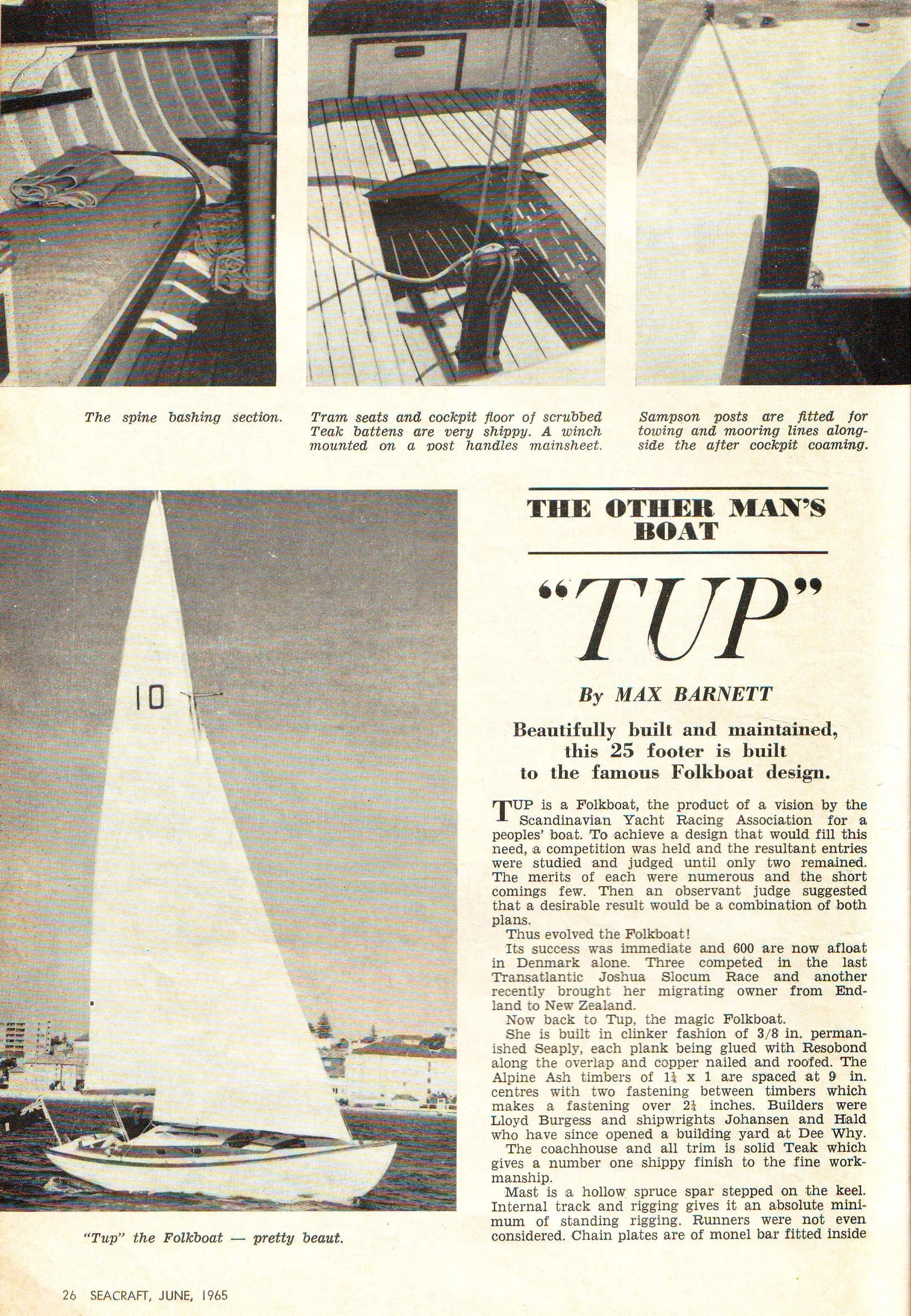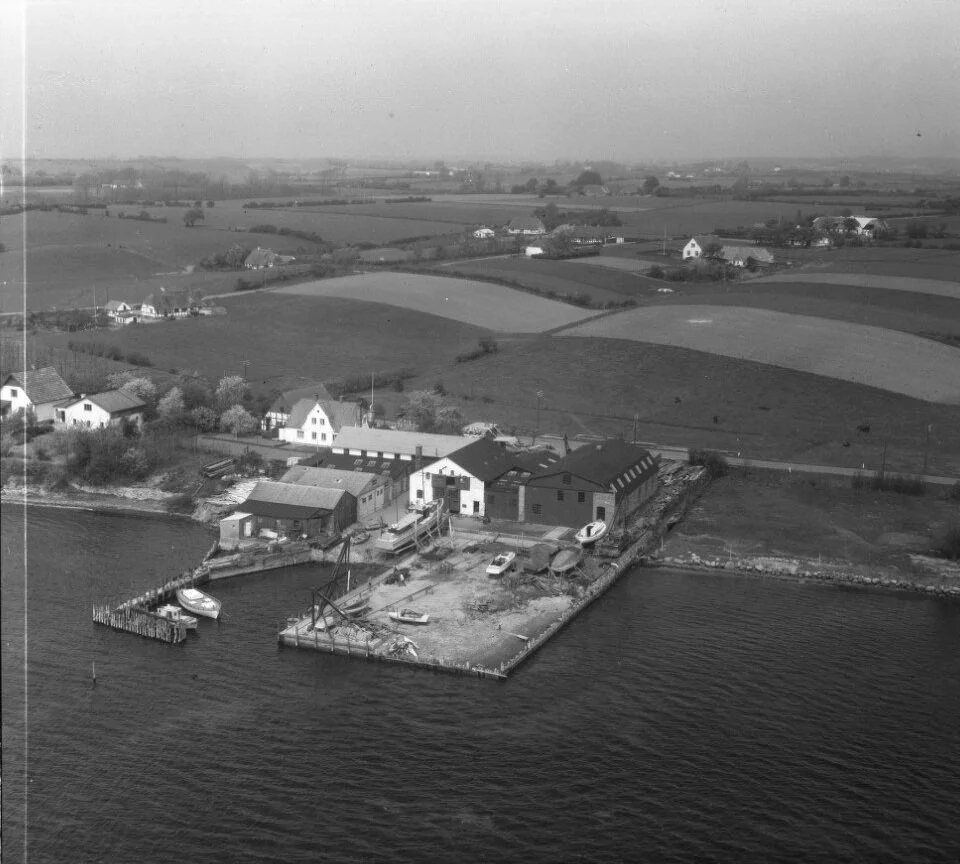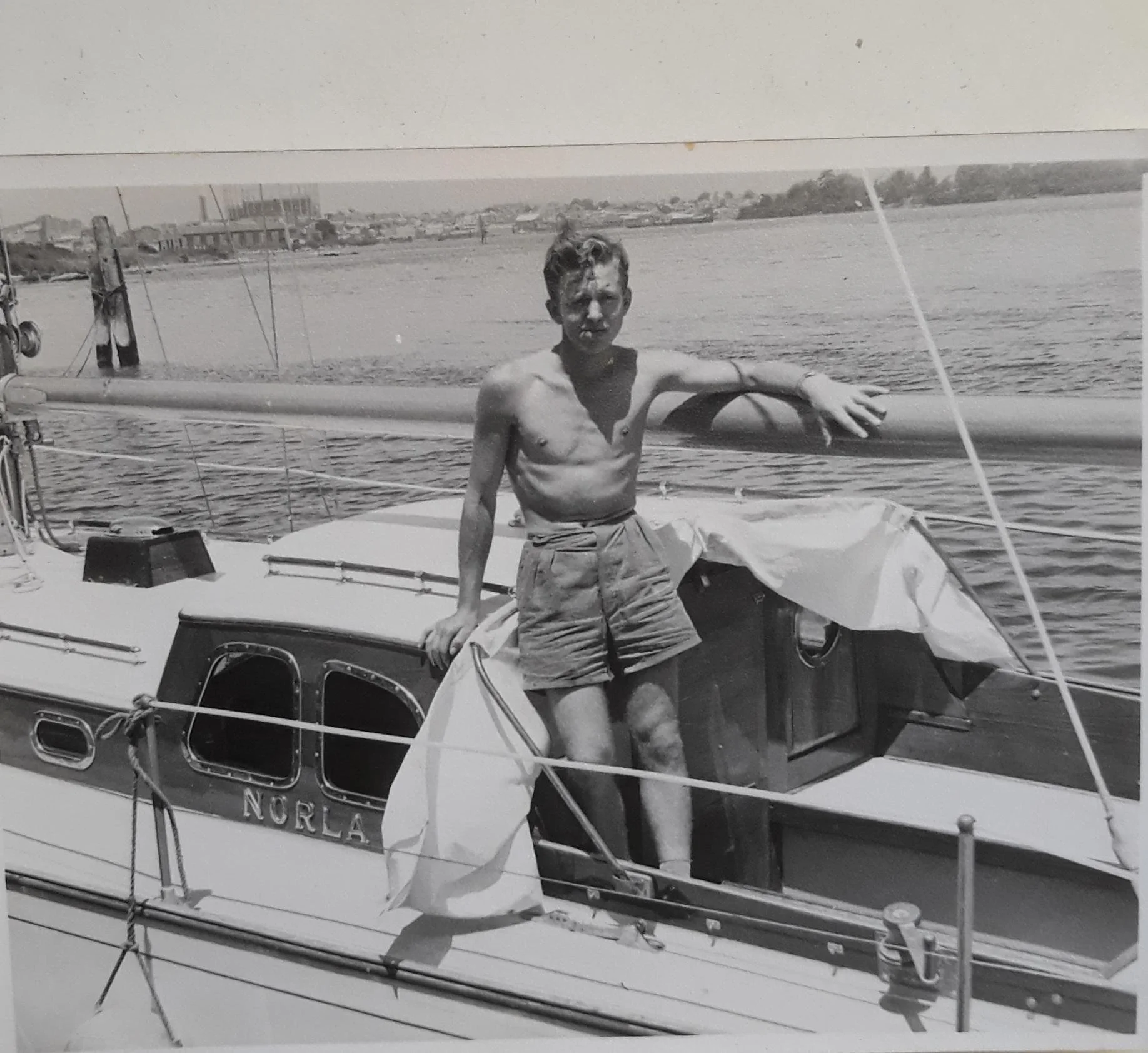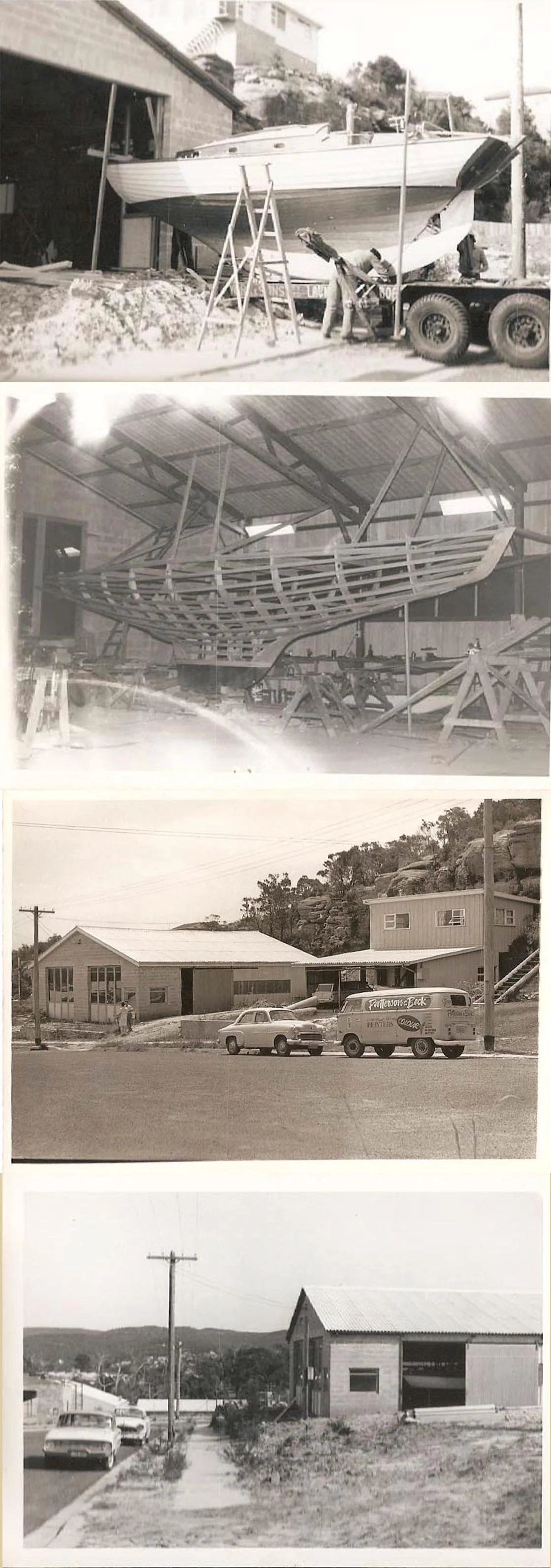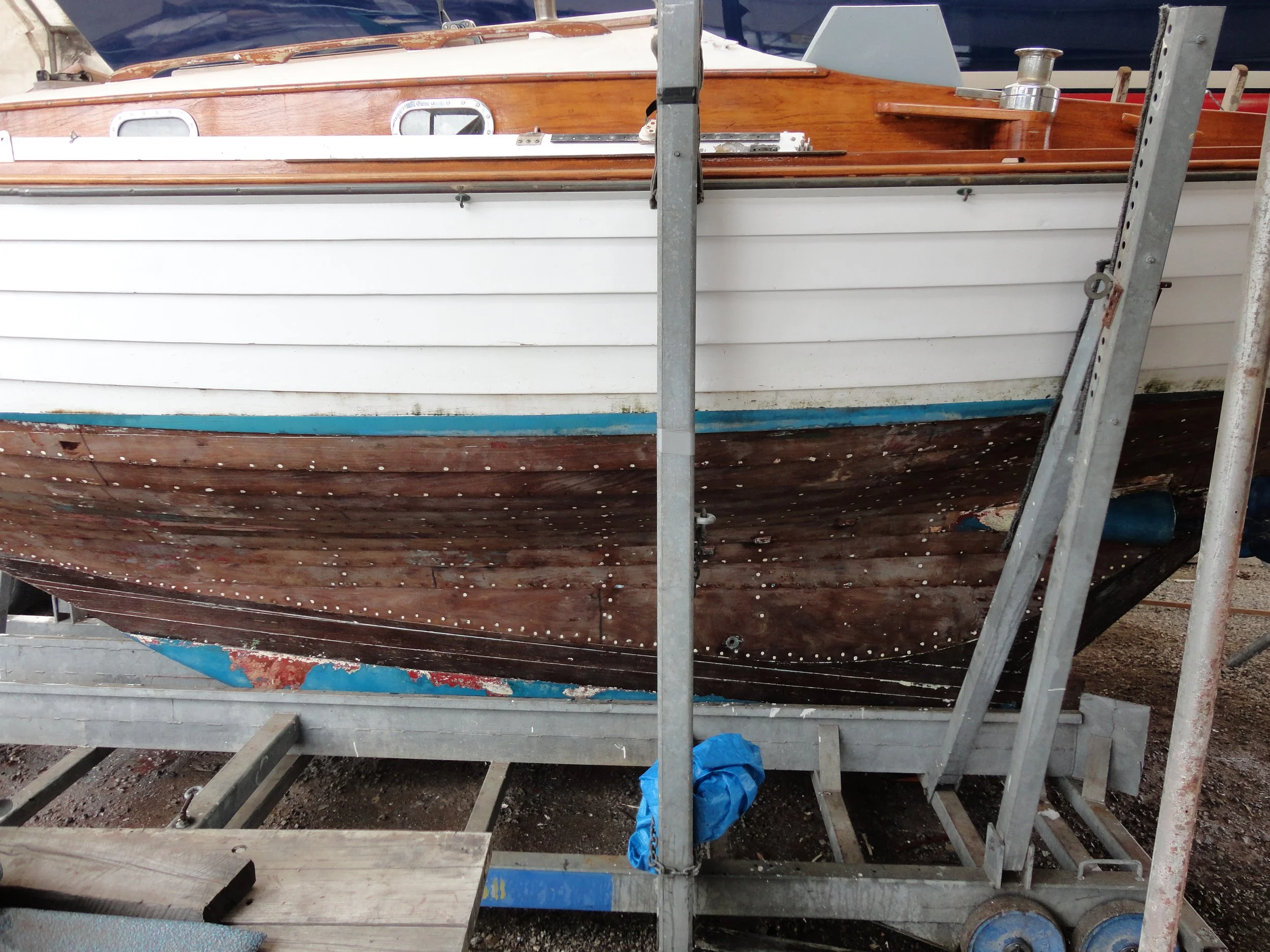Hald and Johansen – Danish boat builders in Sydney in the 1960s.
By Greg Dwyer
PART ONE
In 2005, I'd been back in Sydney for 4 or 5 years after living in the UK for most of the 1990s and was casting around for a new boat. Since my return I'd owned a Joubert Currawong 30 (bought sight unseen on a friend’s recommendation the year before leaving London when a new baby seemed to make a return to Oz inevitable - but that's another story) and a cedar strip planked West system Young 88, in partnership with an old mate.
Now I was after something smaller, probably classic, that I could sail myself and do some Harbour racing in Sydney.
I came across a pretty, seemingly well-kept Nordic Folkboat, being sold by the estate of the last owner, a retired Anglican clergyman. NOCTURNE as she was then known, surveyed well, and I picked her up from her mooring at Beauty Point near the Spit Bridge and took her to a Sydney Amateur Sailing Club mooring in Mosman Bay.
As I later found out, this was the first boat built in Australia by a young Danish shipwright Anders Johansen, who, after teaming up with his uncle John Hald, a carpenter, built more than 30 yachts over 8 or so years in Sydney from 1961 to 1969 before going home to Denmark. A relatively short lived, but skilled and productive period in the last days of regular timber boat building in Sydney.
The advertisement didn’t mention the builder, but I have a note that the broker told me that the boat had been built by Johansen, and when she was slipped for survey at Rabbit’s Cammeray Marina there was a discussion about Hald and Johansen Folkboats. At the time that didn’t mean much to me.
Among the papers with the boat were British Ship registration documents which showed the builder as the first owner, Lloyd Burgess and the original name as TUP - I never did get to the bottom of that, although Shakespearean scholars may be aware of the line in Othello, also familiar to Northern England sheep farmers, about "the old black ram tupping the white ewe". And apparently, along similar lines, a "tup" is the Lancastrian variant of a Liverpool kiss. Not much help there then, and more sensitive souls suggested it might be a diminutive of "tuppence" - for something small, or perhaps a family member's nickname. Luckily I managed not to “butt” into any other boats over my years of racing her on Sydney Harbour.
But I digress. A few months later James Nash, a retired shipwright and member at SASC, asked me if the boat had originally been called TUP. When I confirmed that it had, he gave me a 1965 Seacraft magazine, with the June edition of the article The Other Man's Boat being about TUP.
Seacraft- June 1965
The builders were said to be …”Burgess and shipwrights Johansen and Hald who have since opened a building yard at Dee Why.” That article piqued my interest and from time to time I would make enquiries of people in the marine industry in Sydney. One of those discussions led me to the late Albert (Alby) Jeays a well know Queensland yachtsman, who owned the ketch WOTAMA. In the early 1990s, a letter Alby wrote to Wooden Boat magazine seeking information about the designer – Weber – led to contact with Anders (Andy) Johansen. They corresponded over the years, and Jeays visited Johansen in Denmark, and they also met when Johansen holidayed back in Australia. Alby had kept the letters and kindly sent me copies, together with copies of photos he had received from and taken in Denmark. In 2008, after some internet searching, I found a Johansen living at the address on the letters to Alby Jeays, and made contact with Anders Johansen’s nephew who now lived there. A combination of the Jeays correspondence, information and photographs from the nephew, and various articles in Seacraft magazine and other publications gives some insights into a short but productive period of wooden boat building in Sydney, and another Scandinavian / Australian maritime connection.
Anders Johansen was born and grew up on a farm in Sallinge, Denmark, in 1937. He became an apprentice at the Rantzausminde ship building yard, on the southern end of Funen Island, and completed his training as a shipwright from 1954 to 1958.
Rantzausminde Boatbuilding (1954) Sylvest Jensen, National Library of Denmark
The yard which had closed in the 1980s and is now the site of a residential development apparently specialised in wooden boats, primarily smaller fishing vessels. We know from his letters that he was also familiar with Folkboats. He did his army national service in 1958 and 1959 and apparently built a motor boat in his spare time. He immigrated to Australia in 1960, and got a job with Halvorsens, at Ryde in Sydney. His uncle Johannes (John) Hald, a carpenter or builder, had already come to Australia in 1958 and was working on a farm in Queensland.
Anders wrote to Alby Jeays that while the main activity at the time at Halvorsens was building the famous motor cruisers, many for the hire fleet based at Bobbin Head, he was part of a small yacht building team under the leadership of Trygve Halvorsen. Anders worked on NORLA, being built for the 1961 Sydney Hobart, and on the back of the picture of himself standing on the newly launched yacht on the Parramatta River he noted the very high build quality “typical of Halvorsen built yachts”, pointing out the chrome plated cast bronze name. He added “Gee I was skinny in those days of my youth. I was 23 at the time”.
Anders on NORLA
GRETEL at Halvorsens
His next work was on the Alan Payne designed GRETEL and then when she was finished, they began work on the next Halvorsen Hobart contender, FREYA. Around that time he was introduced to Lloyd Burgess, then the secretary of the Royal Sydney Yacht Squadron, who asked him to build a “Scandinavian Folkboat”, a design he had experience of from his apprenticeship. This was the subject of the Seacraft article in June 1965.
As an interesting aside, and perhaps one of those little career changing quirks of fate which happens to many of us, Johansen was not in fact Burgess’s first choice of builder. A few years ago I was chatting to Ken Beashel at the SASC Gaffers Day, and when I told him I owned Tup, he explained that Burgess had initially approached him to build a Folkboat, but as he had too much work on at the time Burgess had then retained Johansen.
After TUP was built at Smithfield, and possibly another Folkboat, SUZANNE, at Auburn, Anders and John Hald then bought land at Villiers Place in Dee Why in Sydney’s Northern beaches, and built their boat shed.
The Shed at Dee Why
Johansen’s nephew told me that “on this site” they built at least 2 houses in 1968 / 69, from which they earned more money than from boat building!
Over the next 8 or so years, according to one of his letter to Alby Jeays, they built 36 yachts over 25 feet, and a number of smaller boats. They became particularly well known for their Folkboats – of which they built 19. Anders wrote that most of the folkies were planked in glued and copper nailed plywood - Coachwood ply in Tup's case - which Seacraft referred to as “permanished Seaply”, with Resobond resorcinol glue.
When I took TUP back to bare wood below the waterline in 2014 all the original hull was sound – glue and nails doing their job
The Folkboats’ keel timber, stem and stern were generally spotted gum, ribs often laminated alpine ash, and the floors natural growth Tea Tree “which we bought directly from a cutter at Tea Gardens north of Port Stephens”. At least one of the folkies was planked in Huon Pine (KARRAWINGI, now VIVIENNE MARIE) and some were later strip planked mahogany as were many of their larger builds.
Johansen wrote that “Those were hectic and fascinating years of wooden boat building, we tried all kinds of construction methods: ordinary clinker, clinker ply with glued laps, ordinary carvel with glued seams, carvel with splined seams, triple layer laminated, five layer laminated (cold moulding), and strip planking, which was the method we used most, because it was fast to do and also gave a very rigid and strong hull”.
Apart from the 19 Folkboats , which became “John’s specialty” and were advertised in Seacraft as “stock builds”, they built a series of 5.5 meter class yachts for Russel Slade, for Olympic selection trials, 4 Holman Twister class, a 45 foot Giles cruising cutter, and a range of other designs. Sheila Patrick, the editor of Seacraft for whom they built the Folkboat CAPELLA OF KURRABA was a fan and mentioned them a number of times in her articles and Sydney yachting updates.
Anders wrote “Perhaps it was all too much work and too little play in those years. In any case when I got a letter from home with the news that my father was seriously ill did I suddenly become very homesick. We had a long think about the future, we were not unaware that the fiberglass boatbuilders would eventually win out so we decided to sell out and go home”.
The timing and exact circumstances of their departures is a little unclear. Donald Maclurcan’s MORAG BHEAG (believed to be their last yacht) was launched in 1969.
MORAG BHEAG
Sheila Patrick, when flagging that H & J were building a 29 foot JOG class yacht for Owen Hasemer to represent Australia in the Captain Cook Trophy in the UK wrote “this unfortunately will be the last boat that these two expert boatbuilders make. John, homesick for the green fields of Denmark is returning home, and Andy, a farm boy at heart, is going cattle raising in Queensland. This will be a severe blow to those yachtsmen who love a well fashioned wooden craft, as boatbuilding seems to be a dying art these days” And this in 1969! Given what Anders wrote to Alby Jeays, it may be that Seacraft had their John / Anders facts in reverse.
In any event, when Anders returned to Denmark he bought a farm which we worked for some years before selling it, and during that time, in 1972, he also bought a site in Jutland and started his own boat yard building wooden yachts and fishing boats. He had 8 employees. Unfortunately, in 1977 the business fell on hard times and he was forced to sell it. As he wrote to Alby Jeays in March 1992 “In Denmark I have since had my ups and downs in the boatbuilding business and now, after a long and rather unpleasant time in fiberglass boatbuilding, I do have a small one-man workshop where I’m building boats and yachts in wood only.” He built some “cruising Folkboats” and a 36 foot “double ender”.
Photo-Alby Jeays
He built his own sailing boat called, shades of Sheila Patrick, CAPELLA, but I don’t have details of her design – perhaps a folkie?
In 1979 he had travelled to New Zealand. He had friends there who had started to build a boat, and after the husband died he wanted to help the wife – named Nancy – to finish the build. He also travelled to Queensland in 1994 to catch up with Alby Jeays, and wrote on his return to Denmark that he was renovating the “Seamaster” – perhaps the Giles 19 foot design?
John Hald died of cancer in the mid-1990s and in the same letter telling Albie Jeays about this, Anders wrote that the only boat building he had done for a while was to finish of a couple of Herreshoff cruising dinghies, about 11ft 6in long, known as the MARCO POLO tender design. He planned to do some coastal “off the beach” cruising.
Whether those plans were fulfilled I don’t know. By the time I had tracked down his nephew Anders had fallen ill, after a series of “brain hemorrages” and was pretty much incapacitated and living in a nursing home.
A letter from the home told me that while he had lost the capacity to speak, after my letters to his nephew were read to him “he is all smiles and tears in joy from hearing from you.”
Anders died in late 2009. Having sold TUP in late 2019, she is now moored at Salt Pan Creek in Pittwater, renamed NORDISK FOLKBAT, after some lovely updating by retired Queensland shipwright Ian Powell. I am now the custodian of one of the 4 Twisters, CASUARINA, and in Part 2 of this story I will look at a number of the H & J yachts, some of them still being actively sailed, and indeed, raced.


